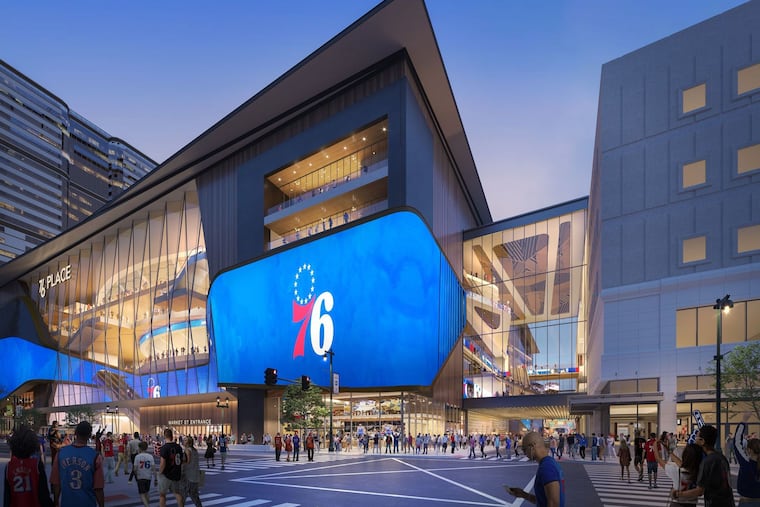First glimpse into Sixers’ arena studies shows a Chinatown grappling with higher rents and taxes
Chinatown supporters question the team's assertion that building a downtown arena will not displace a single home or business

Chinatown’s population has grown — and so has the cost of living there, according to new research that’s intended to help Philadelphia officials decide whether to let the Philadelphia 76ers build a $1.55 billion arena in Center City.
The neighborhood that abuts the site where the team wants to put its next home has nearly doubled in residents since 2011, to 6,919 from 3,841.
Its median income has increased, businesses have opened, and more services and programs that serve the community have settled there, explained Sarah Yeung, co-founder and principal of Sojourner Consulting of Philadelphia, one of the firms hired to conduct city-sponsored impact studies.
“Chinatown is still Chinatown,” she said this week at a meeting in Chinatown that offered the first peek into the work being compiled in the city studies. “It’s still a living, cultural community.”
Yeung’s presentations on Thursday at the Chinese Christian Church and Center, and on Wednesday night on Zoom to Washington Square West neighbors, featured no big revelations. Instead, it offered a detailed statistical look at the historic immigrant gateway, where community polls show 90% opposition to the arena. A third presentation followed at the church center on Thursday night.
“I didn’t hear the word gentrification mentioned,” veteran Chinatown activist Mary Yee told the experts, “but for some of these things, gentrification is going to be the result.”
The arena would stand on the footprint of 10th to 11th and Market to Filbert Streets, claiming the former Greyhound bus station and one-third of the Fashion District mall, abutting Chinatown at Cuthbert Street.
The Sixers say the 18,500-seat arena would not harm or gentrify Chinatown. It would, they say, drive foot traffic, spending, tax revenue, and business growth, and help revitalize a ragged stretch of East Market Street without displacing businesses or homes. The team is currently a tenant at the Wells Fargo Center in South Philadelphia.
“We look forward to the study being completed and hearing additional findings,” Mark Nicastre, a spokesperson for the team on arena matters, said in a statement on Friday, adding that the project team had no role in the studies nor was briefed on them.
The Sixers already have taken steps to address concerns that have been raised, he said. For example, he said, after receiving community feedback, the project added a residential tower that includes affordable housing.
Meanwhile, the Chinatown Coalition to Oppose the Arena has scheduled a community town hall meeting for Tuesday at the Chinese Christian Church at 10th and Spring Streets. And the Sixers announced that they would hold a public, in-person meeting at the Sheraton Philadelphia Downtown on Thursday.
“We are looking forward to continuing the dialogue,” David Gould, the team’s chief diversity and impact officer, said in a statement this week. “It’s important for us to share our plans and learn more about the priorities and needs of the community.”
The Kenney administration and the city’s public-private development agency, the Philadelphia Industrial Development Corp., hired consultants to examine three core elements of the team’s proposal: design, economics, and community impact. Sojourner and BJH Advisors, a New York real estate planning company, are conducting the community study.
Elected officials say the studies, paid for by the Sixers, would be key to their decisions. The economic and community assessments are expected by the end of the year, before the new mayor and City Council are seated in January.
How is the city examining the arena’s potential impact?
Yeung explained that Chinatown has strengthened as a hub for services and programs, with about 101 different groups serving the community, up by 23 since 2014. And there’s hope that a proposal to cap the Vine Street Expressway, which has long bisected the community, could offer reconnection and room for growth.
She also said that Chinatown’s recovery from the pandemic remains ongoing. It has lost parking spaces to development. Median real-estate taxes have risen 64% for commercial properties and 66% for mixed-use properties since 2014.
Higher rents have displaced low-income immigrants, and the percentage of residents who identify as “Asian alone” dropped from 51% in 2011 to 38% in 2021.
The aim of the research is to examine the most-impacted neighborhood, Chinatown, but also to explore an arena’s potential influence on surroundings that include Washington Square West.
Other research is occurring, as well. Ian Litwin, a planner with the Philadelphia Planning Commission, said the Sixers have redone their traffic study at the city’s request, partly to enlarge the survey area. Thomas Jefferson University Hospital, located a block south of the project site, is analyzing how ambulances would be affected, he said at the meetings.
The community study, Yeung said, will consider the influence of three arenas built elsewhere: The Golden 1 Center in Sacramento, Calif., home of the National Basketball Association’s Kings; the Barclays Center in Brooklyn, where the Nets play; and Capital One Arena in Washington, which hosts the NBA’s Wizards and the National Hockey League’s Capitals.
The Washington arena, opened in 1997, is often blamed for the gentrification of that city’s Chinatown.